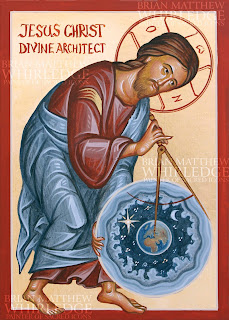Prilep: Varosh, Zrze, Treskavec, and Manastir
 |
| St. Nicholas Manastir |
Saint Nicholas Varosh
Saint Nicholas church is a tiny parish church in the old Varosh neighborhood in Prilep. The frescoes date from 1298.
The angels wear fabulous mannerist robes that ripple with energy. The icons are influenced by the important Kurbinovo church, which we will visit tomorrow.
 |
I enjoyed capturing the curvilinear undulation of the garments in this quick sketch.
 |
| The tiny Saint Nicholas Varosh |
We saw hundreds of these drying tents today, both in the city of Prilep and in the surrounding countryside.
Saint Demetrius VaroshSaint Demetrius is another parish church in Varosh. It is an unusual 3-aisled domed basilica, with influences from Thessaloniki. The side aisles are not separated by a typical colonnade, but rather solid walls, indicating a cloistered monastic community that could worship alongside lay parishioners without interaction. Frescoes are in a poor state of conservation. The communist Yugoslav government experimented with cutting edge conservation technology in the mid 20th century which has caused irreversable damage. Zrze Monastery of the TransfigurationWe drove about 45 minutes from Prilep through a large valley. The arid plain surrounded by rugged mountains reminded me a lot of Colorado. The entire west wall is frescoed on the exterior, showing the last judgement. This 14th century icon of the Transfiguration is so dynamic, I had to sketch it. There is so much movement in the way the Lord turns his body and the high angle of his blessing arm. I presume the monastery is named for the Transfiguration since it is high up on a mountain. The frescoes in the nave were painted in 1369. The iconographic program is quite unusual. The west wall features the Communion of the Apostles (usually found in the Sanctuary) instead of the traditional Dormition of the Theotokos. The east wall showcases an impressive program. Near the ceiling is Christ Pantocrator and the four evangelists. This cycle is usually in the dome, but this domeless church prominently palces these icons high on the east wall. Below is the traditional Theotokos Platytera (more spacious than the heavens), Annunciation, and Hierarchs. TreskavecWe drove down the mountain, across the valley, then back up a rocky mountain on the opposite side. Treskavec is perched high on a mountain above the city of Prilep. "Prilep" means "glued" because these stones look like they are glued in place, too precarious to defy gravity any other way. Treskavec (Trace-kah-vetz) has been a site of religious importance for over 3,000 years. A shrine to Apollo was established at the peak of the mountain, then a village of about 3,000 people sprang up at the site of the monastery. The temple of Apollo was dismantled and reassembled into an early Christian church. Ancient marble elements can still be seen embedded into the church architecture. The church has had additions in every century. The abbot joked "If someone asks which century was the church built, I tell them to pick a century, and I can tell them which part of the church was added in that century." The incredible frescoes have a history parallel to the church building. The walls are palimpsests, with different periods showing in different parts. Conservation will be difficult, because there are layers of frescoes from different periods. Most notable are 14th century frescoes by Eutyches and Michael Astrapas when King Milutin left his mark on this monastery. The church was damaged in a fire and is currently undergoing extensive conservation and renovation. A side chapel presents incredibly unique frescoes, found nowhere else in the world. The dome depicts the Divine Council with remarkable clarity. Christ Pantocrator is crowned as the Emperor. The Theotokos is vested in imperial regalia as the Queen of Heaven, as she stands to the right of the throne of the King of kings. Surrounding them is the court: angels of course, but most interestingly, military saints, not shown as soldiers with armor and weapons, but in these unique frescoes, they are shown as nobility in royal dress of the period (14th century). Saint George as a Noble This theme is continued in the nave, with frescoes of Saints George and Demetrius dressed as nobles. These most remarkable frescoes show military saints not as soldiers, but as royalty. They are nobles serving in the imperial court of the King of kings. This is the only place in the world where icons of this type are found. Saint Demetrius as a Noble Interestingly, Saint John of Shanghai and San Francisco served as a priest in this monastery in the 1930s when he taught at the nearby seminary in Bitola. Saint Nicholas Monastery, ManastirAn hour's drive south of Prilep took us into mountain highlands to the remote ghost-town of Manastir. The active Monastery is beautifully rebuilt, with excavations and renovations underway at the church proper. The Theotokos is flanked by beautifully painted angels. The frescoes were painted in 1270. The church is a large, three-aisled basilica, quite remarkable for a remote village. There were no royal patrons or famous painters for this church. If villagers could create such beauty, imagine what magnificence existed in churches in every city, village, and countryside across Christendom 750 years ago! The Archangels at Manastir are remarkably similar to the frescoes at Varosh, which we saw this morning. The Root of Jesse Saint Panteleimon This frieze of saints is in poor condition, but the clothing is exquisite! It will be an invaluable reference for my own icon painting. After a beautiful evening drive back to Prilep, I enjoyed some urban sketching and Greek salad in the city center. Tomorrow, we'll visit Kurbinovo and Ohrid to study some of the most important extant frescoes. |

























































Comments
Post a Comment